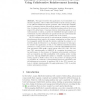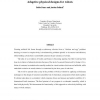34 search results - page 6 / 7 » Learning Policies for Embodied Virtual Agents through Demons... |
JMLR
2002
13 years 4 months ago
2002
Lyapunov design methods are used widely in control engineering to design controllers that achieve qualitative objectives, such as stabilizing a system or maintaining a system'...
BERTINORO
2005
Springer
13 years 10 months ago
2005
Springer
Abstract. This paper describes the application of a decentralised coordination algorithm, called Collaborative Reinforcement Learning (CRL), to two different distributed system pr...
CHI
2009
ACM
2009
ACM
Social immersive media: pursuing best practices for multi-user interactive camera/projector exhibits
14 years 5 months ago
Based on ten years' experience developing interactive camera/projector systems for public science and culture exhibits, we define a distinct form of augmented reality focused...
ALIFE
1998
13 years 5 months ago
1998
Creating artificial life forms through evolutionary robotics faces a “chicken and egg” problem: learning to control a complex body is dominated by problems specific to its s...
NECO
2007
13 years 4 months ago
2007
Learning agents, whether natural or artificial, must update their internal parameters in order to improve their behavior over time. In reinforcement learning, this plasticity is ...


